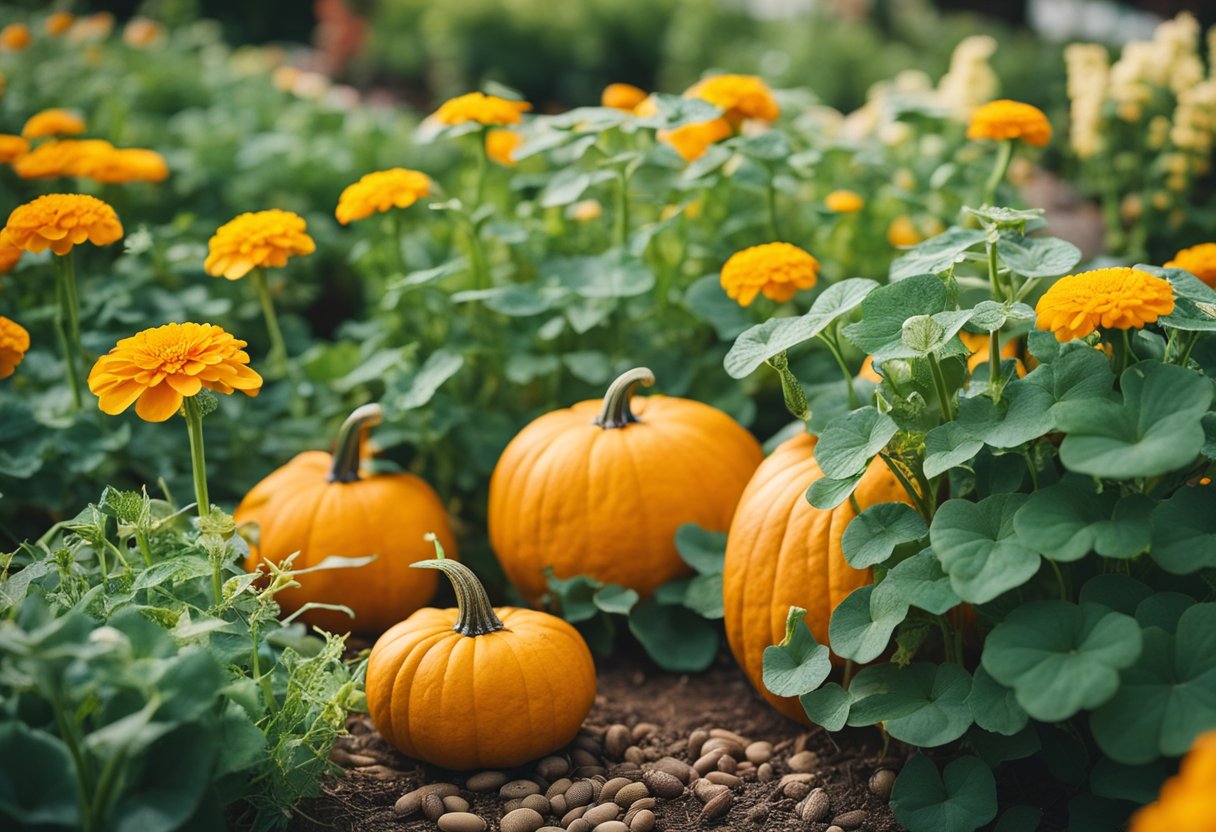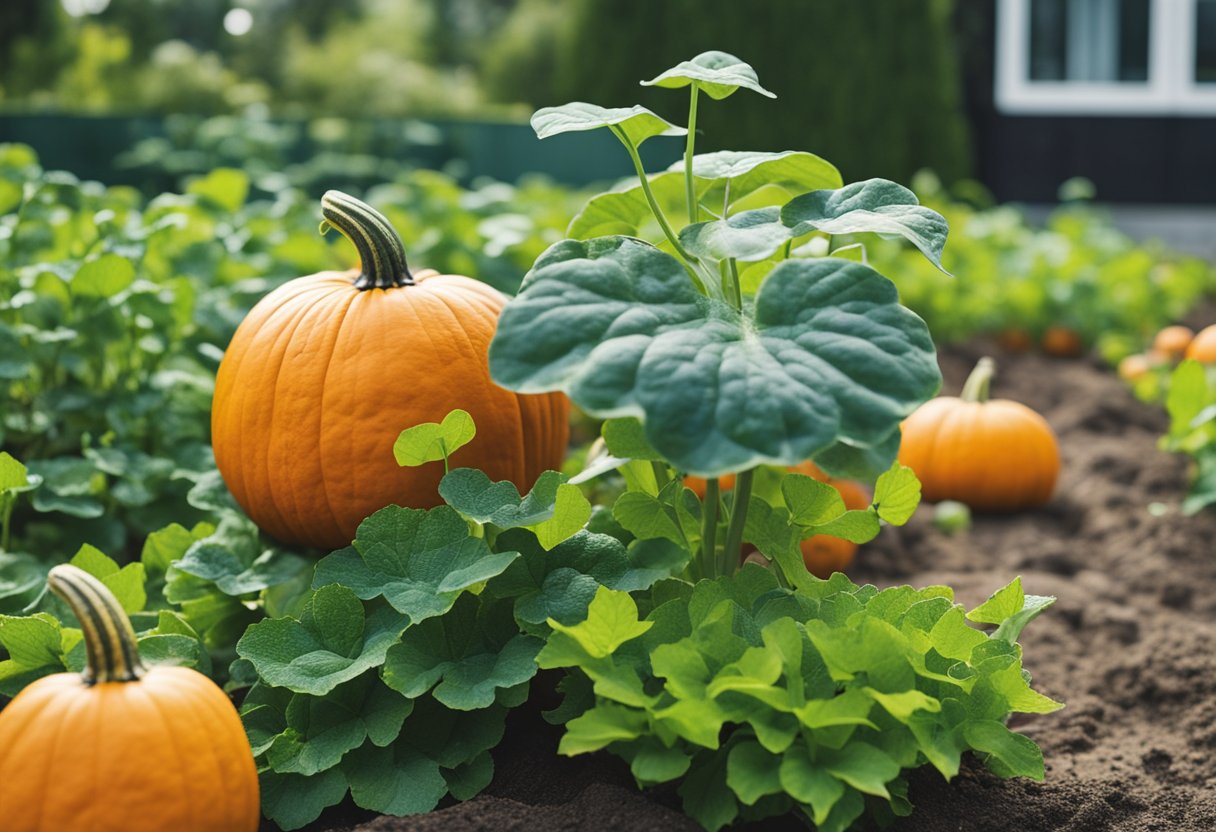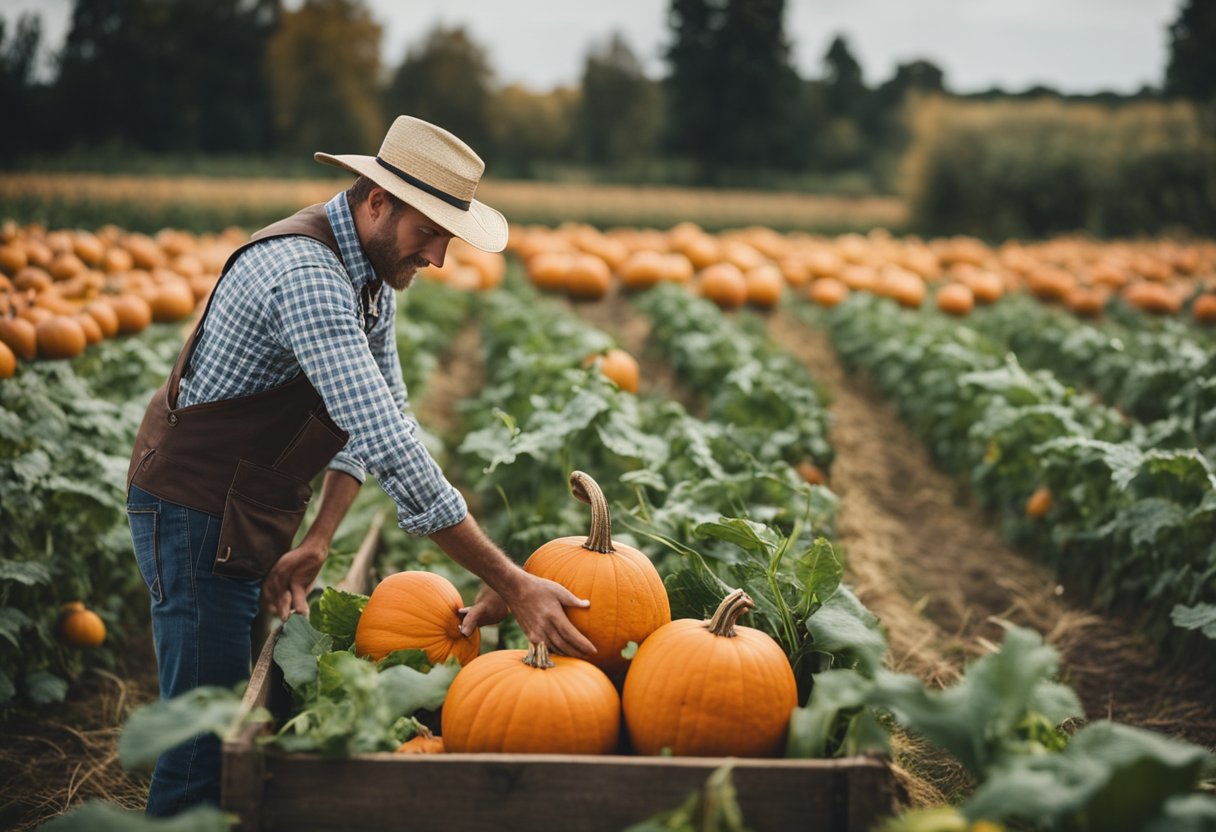As a gardener, I know that companion planting is a great way to maximize the potential of your garden. Pumpkin companion plants are especially important because pumpkins require a lot of space and nutrients to grow properly. By planting compatible plants in close proximity, you can help your pumpkins thrive and also enjoy the benefits of a diverse garden.

Companion planting with pumpkins has many benefits. Certain plants can attract beneficial insects to your garden, such as bees and ladybugs, which can help pollinate your pumpkin plants and keep harmful pests at bay. Other plants can help to suppress weeds and improve soil health, which can lead to healthier pumpkins. Additionally, companion planting can help to conserve space in your garden by allowing you to grow multiple plants in the same area.
When it comes to choosing the best companion plants for pumpkins, there are many options to consider. Some of the most popular companion plants for pumpkins include corn, beans, marigolds, and nasturtiums. These plants can help to promote healthy growth and improve the flavor of your pumpkins. However, it’s important to avoid planting incompatible plants such as potatoes and brassicas like kale, broccoli, and cabbage, which can compete with pumpkins for nutrients and space.
Key Takeaways
- Companion planting with pumpkins can help to maximize the potential of your garden and promote healthy growth.
- The best companion plants for pumpkins include corn, beans, marigolds, and nasturtiums, while incompatible plants such as potatoes and brassicas should be avoided.
- Proper soil preparation and maintenance, planting strategies, and harvesting and storing techniques are important for growing healthy pumpkins.
Benefits of Companion Planting
As a gardener, I have found that companion planting is an effective way to improve the health and productivity of my crops. By planting certain plants together, I have been able to reap the benefits of pest control, pollination support, soil health, and spatial efficiency.
Pest Control
One of the most significant benefits of companion planting is pest control. Certain plants can help repel pests that would otherwise damage or destroy your crops. For example, planting marigolds alongside pumpkins can help repel beetles and other insects that would otherwise feast on the leaves and fruit of the pumpkin plant. Similarly, planting onions and garlic near your pumpkin plants can help repel pests like aphids and spider mites.
Pollination Support
Another benefit of companion planting is pollination support. Some plants can attract beneficial pollinators like bees and butterflies, which can help ensure that your pumpkin plants produce healthy and abundant fruit. For example, planting flowers like zinnias and sunflowers near your pumpkin plants can help attract pollinators to your garden.
Soil Health
Companion planting can also help improve soil health. Certain plants can add nutrients to the soil or help break up compacted soil, which can improve the health and productivity of your crops. For example, planting legumes like beans or peas near your pumpkin plants can help add nitrogen to the soil, which can help your pumpkin plants grow strong and healthy.
Spatial Efficiency
Finally, companion planting can help you make the most of your garden space. By planting certain plants together, you can help maximize your garden’s productivity and reduce the need for additional space. For example, planting pumpkins alongside corn and beans can help create a symbiotic relationship between the plants, where the corn provides a trellis for the beans to climb, and the beans help fix nitrogen in the soil, which can benefit the pumpkins.
Companion planting is a simple and effective way to improve the health and productivity of your pumpkin plants. By planting certain plants together, you can reap the benefits of pest control, pollination support, soil health, and spatial efficiency, and help your pumpkin plants grow strong and healthy.
Best Companion Plants for Pumpkins
As an experienced gardener, I have found that planting companion plants alongside pumpkins can significantly improve their growth and health. In this section, I will share some of the best companion plants for pumpkins that I have personally used in my garden.
Marigolds
Marigolds are a popular companion plant for pumpkins because they help to repel pests such as nematodes, beetles, and aphids. These bright, colorful flowers also attract beneficial insects like ladybugs, lacewings, and hoverflies, which prey on pumpkin pests.
Nasturtiums
Nasturtiums are another great companion plant for pumpkins. These edible flowers have a peppery taste and are rich in vitamin C. They also attract pollinators like bees and butterflies, which help to increase pumpkin yields.
Corn
Corn is a tall, stately plant that makes an excellent companion for pumpkins. The two plants grow well together because corn provides shade for the pumpkin leaves, which helps to keep the soil moist and cool. Additionally, the pumpkin vines help to stabilize the corn stalks during windy weather.
Beans
Beans are a nitrogen-fixing plant that can help to improve the soil quality around pumpkins. The beans convert atmospheric nitrogen into a form that can be used by plants, which helps to promote healthy pumpkin growth. Additionally, the dense foliage of bean plants provides shade and helps to suppress weeds.
By planting these companion plants alongside pumpkins, gardeners can help to improve soil quality, repel pests, attract beneficial insects, and increase yields. I highly recommend trying out these companion plants in your own pumpkin patch for a healthy and bountiful harvest.
Avoiding Incompatible Plants

As much as companion planting can benefit pumpkins, planting certain crops together can also result in poor growth and yield. Here are a few plants that are not compatible with pumpkins:
Potatoes
Potatoes and pumpkins are both members of the nightshade family, and planting them together can lead to the spread of diseases such as blight and verticillium wilt. Additionally, both plants require a lot of space and nutrients, so planting them together can lead to competition for resources.
Cucumbers
Cucumbers and pumpkins are both vines that can easily intermingle, but planting them together is not recommended. Cucumbers are susceptible to powdery mildew, which can spread to pumpkins and cause poor growth and yield. Additionally, cucumbers and pumpkins have different nutrient requirements, so planting them together can result in stunted growth.
It’s important to note that these are not the only incompatible plants for pumpkins. It’s always a good idea to research the needs and compatibility of plants before planting them together.
While companion planting can be beneficial for pumpkins, it’s important to avoid planting incompatible plants together. Potatoes and cucumbers are just a few examples of plants that should not be planted with pumpkins.
Also Read | Companion Plants for Grape: Enhancing Growth and Yield
Planting Strategies

When planting pumpkin companion plants, it is important to consider timing and spacing, crop rotation, and vertical gardening. These strategies can help maximize the benefits of companion planting and ensure a healthy and productive garden.
Timing and Spacing
When planting pumpkin companion plants, it is important to consider their growth habits and timing. Some plants, such as corn and sunflowers, can grow quite tall and may shade out other plants if they are not spaced properly. Other plants, such as radishes and lettuce, have shallow roots and can be planted closer together.
To maximize space and sunlight, consider intercropping pumpkin companion plants with different growth habits. For example, plant low-growing plants such as radishes and lettuce between rows of taller plants such as corn and sunflowers. This can help maximize space and sunlight, while also providing natural weed suppression and pest control.
Crop Rotation
Crop rotation is another important strategy for planting pumpkin companion plants. Rotating crops can help prevent the buildup of pests and diseases in the soil, while also improving soil health and fertility.
When planning your garden, consider rotating pumpkin companion plants with different families of plants each year. For example, rotate pumpkins with members of the brassica family (such as broccoli and cabbage) one year, and with members of the legume family (such as beans and peas) the next year. This can help prevent soil-borne diseases and pests from taking hold, while also improving soil health and fertility.
Vertical Gardening
Vertical gardening is another strategy for maximizing space and sunlight in your garden. By growing pumpkin companion plants vertically, you can help reduce competition for sunlight and space, while also improving air circulation and reducing the risk of pests and diseases.
Some pumpkin companion plants, such as pole beans and indeterminate tomatoes, are naturally suited to vertical gardening. Other plants, such as cucumbers and melons, can be trained to grow up trellises or other supports. By incorporating vertical gardening into your garden plan, you can help maximize space and sunlight, while also improving plant health and productivity.
Soil Preparation and Maintenance
As a pumpkin grower, I know that soil preparation and maintenance are crucial for a successful harvest. Here are some tips that I have learned over the years to help you get the most out of your pumpkin patch.
Composting
Composting is a great way to improve the quality of your soil. By adding organic matter to your soil, you can increase its fertility, water-holding capacity, and overall health. You can make your own compost by collecting yard waste, kitchen scraps, and other organic materials. Once you have collected enough material, mix it together in a compost bin and let it decompose. After a few months, you will have a nutrient-rich compost that you can add to your soil.
Mulching
Mulching is another great way to improve your soil’s health. By adding a layer of organic material on top of your soil, you can reduce weed growth, retain moisture, and regulate soil temperature. Some great mulching materials for pumpkins include straw, leaves, and grass clippings. Simply spread a layer of mulch around your pumpkin plants, making sure to leave a small space around the stem to prevent rotting.
Irrigation
Pumpkins require a lot of water to grow properly. It is important to water your plants regularly, especially during hot and dry weather. You can use a sprinkler system, a soaker hose, or hand watering to keep your plants hydrated. Make sure to water your plants deeply, so that the water reaches the roots. It is also important to avoid getting water on the leaves, as this can promote the growth of fungal diseases.
By following these tips for soil preparation and maintenance, you can ensure that your pumpkin plants have the best possible growing conditions. With a little bit of effort, you can enjoy a bountiful harvest of healthy and delicious pumpkins.
Harvesting and Storing Pumpkins

Harvesting Techniques
When it comes to harvesting pumpkins, it’s important to wait until they are fully matured. This means that the skin should be hard and the stem should be dry and woody. To harvest, use a sharp knife or pruning shears to cut the stem about 2-3 inches above the pumpkin. Be careful not to damage the pumpkin or the stem, as this can lead to rotting during storage.
Curing Process
After harvesting, pumpkins should be cured for about 10 days to toughen their skins and extend their storage life. To do this, place the pumpkins in a warm, dry area with good air circulation, such as a sunny windowsill or a covered porch. Make sure to keep them out of direct sunlight, as this can cause sunscald.
Storage Conditions
Once cured, pumpkins can be stored in a cool, dry place with good ventilation. Ideal storage conditions include a temperature between 50-55°F and a humidity level of 50-70%. Avoid storing pumpkins near fruits that give off ethylene gas, such as apples, as this can cause premature ripening and spoilage.
It’s important to regularly check stored pumpkins for signs of rot or decay. If any pumpkins show signs of soft spots or mold, remove them immediately to prevent the spread of decay to other pumpkins. With proper harvesting and storage techniques, pumpkins can last up to several months.
FAQs – Pumpkin Companion Plants
What are the best flowers to plant alongside pumpkins for companion planting?
Marigolds are a great choice for planting alongside pumpkins. They help repel pests and attract beneficial insects like ladybugs and lacewings. Additionally, sunflowers, nasturtiums, and zinnias are also great companion plants for pumpkins as they attract pollinators like bees and butterflies.

What considerations should be made when planting pumpkins and peppers together?
It is generally not recommended to plant pumpkins and peppers together as they have different soil and watering requirements. Pumpkins require more water and nutrients than peppers, and planting them together may result in stunted growth for both plants. Additionally, pumpkins tend to take up a lot of space, which may shade the peppers and reduce their yield.
Are there any benefits to planting watermelons near pumpkins?
Watermelons and pumpkins can be planted together as they have similar soil and watering requirements. Additionally, watermelons can help shade the soil and reduce evaporation, which can benefit the pumpkins. However, it is important to note that watermelons require more space than pumpkins, so it is important to give them enough room to grow.
Which companion plants are ideal for growing with zucchini and pumpkins?
Zucchini and pumpkins are both members of the squash family and can be planted together. Companion plants that are ideal for growing with zucchini and pumpkins include beans, corn, and radishes. Beans and corn help provide shade and support for the squash plants, while radishes help repel pests like squash bugs.
What should be avoided when planting pumpkins in proximity to tomatoes?
It is generally not recommended to plant pumpkins in proximity to tomatoes as they are both susceptible to similar diseases like blight and can attract the same pests like aphids. Additionally, pumpkins require more water and nutrients than tomatoes, which may result in stunted growth for both plants.
Is it advisable to grow pumpkins and cucumbers in the same garden space?
Pumpkins and cucumbers can be grown together as they have similar soil and watering requirements. However, it is important to note that pumpkins require more space than cucumbers, so it is important to give them enough room to grow. Additionally, cucumbers can attract cucumber beetles, which can also attack pumpkins, so it is important to monitor for pests and use preventative measures if necessary.